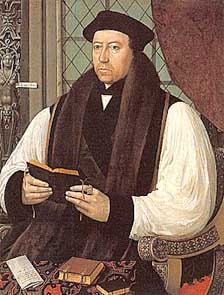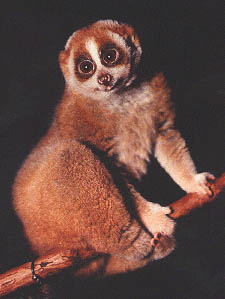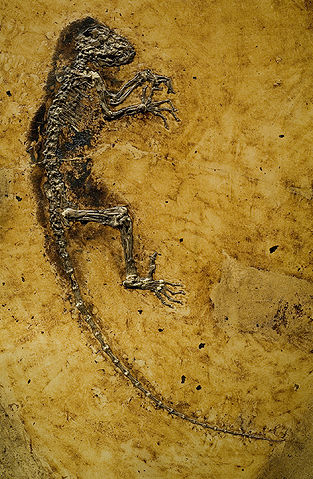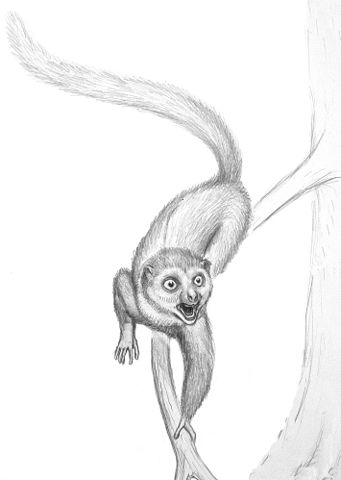
Thomas Cranmer (1489-1556), Archbishop of Canterbury and first Primate of the Church of England.
| Primates | ||
| The Vertebrates | Primates |
| Vertebrates Home | Vertebrate | Vertebrate |
|
Abbreviated Dendrogram
Archonta
│
└─Primates
├─Strepsirhini
│ ├─Lorisiformes
│ └─Lemuriformes
│ ├─Indrioidea
│ └─Lemuroidea
└─┬─Adapiformes
└─┬─Darwinius
└─Haplorhini
├─Tarsiiformes
└─Anthropoidea
├─Platyrrhini
└─Hominoidea
|
Contents
Overview |
Taxa on This Page

|
|
Thomas Cranmer (1489-1556), Archbishop of Canterbury and first Primate of the Church of England. |
Primates: Lemurs, monkeys, aye-ayes, Anglicans & apes.
from the Late Cretaceous or early Paleocene.
Primatomorpha : Plesiadapiformes + * : Strepsirhini + Haplorhini.
Shortened rostrum; addition of hypocone & loss of paraconid from basic tribosphenic pattern; bunodont cusps; loss of at least 1 incisor and 1 premolar in all but most basal forms; orbits face anteriorly, with stereoscopic vision & well-developed vision; ethmoid exposed on orbital wall; postorbital bar; enlarged brain; floor of auditory bulla from petrosal; clavicle retained as prominent element of pectoral girdle; shoulder joint with broad mobility; digits 5/5; opposable digits; tactile pads at ends of digits; elongated hind limb; facultative bipedalism common; nail on hallux and other digits; herbivorous or omnivorous; 2 mammaries; 1-2 young per pregnancy; long gestation and developmental time; frequently highly social, with flexible dominance hierarchies; strongly adapted to arboreal life.
Links: Electronic Zoo / NetVet Veterinary Resources - Primate Sites; Primates; About the Primates; Fossil Primates 1; Fossil Primates 2; Primates Prof. Eernisse's usual great job of weaving together web resources and notes); Higher Primates May Have Asian Root, Science News Online (10/16/99).
Strepsirhini: Lemurs, lorises, etc. Purgatorius?
Range: from the Early Eocene of Asia, Europe, North America & Africa.
Phylogeny: Primates : (Adapiformes + (Darwinius + Haplorhini)) + * : Lorisiformes + Lemuriformes.
Characters: naked rhinarium [V+00]; unfused nasal prominences [V+00]; slit-like nostrils [V+00]; $ tapetum lucidum present; $ tooth comb formed by lower incisors & canines (lost in some lemuriforms) [V+00]; $ grooming claw on pes 2 [V+00].
Links: Image of toothcomb at Animal Diversity Web.
References: Vaughan et al. (2000) [V+00]. ATW021116.
 Lorisiformes: Arctocebus, Loris, Nycticeboides, pottos, lorises & galagos.
Lorisiformes: Arctocebus, Loris, Nycticeboides, pottos, lorises & galagos.
Range: from the Miocene of Africa, Madagascar, & South Asia
Phylogeny: Strepsirhini : Lemuriformes + *.
Characters: low pre-orbital skull; eyes face forward with thin interorbital septum [V+00]; head round [N91]; braincase globular; tooth comb present; dental formula 1-2/2, 1/1, 3/3, 3/3 [V+00]; upper incisors small [V+01]; lower canine incisiform [V+01]; molars quadritubercular; hind limbs same length or longer than forelimbs [N91]; digits specialized for climbing; strong digital flexors; digits with nails or claws [V+00]; slow, arboreal hand-over-hand climbers; insectivorous, carnivorous or frugivorous; prey captured with hands; nocturnal.
Links: The Primates: Prosimians: Part II; Lecture 18 - Primates (Streps.); Primate Taxonomy; genetenw00.pdf.
References: Nowak (1991) [N91]; Vaughan et al. (2000) [V+00]. ATW021116.
 Lemuriformes: Daubentonia, Lepilemur, Megaladapis.
Lemuriformes: Daubentonia, Lepilemur, Megaladapis.
Range: from the Middle Eocene Oligocene?) of Africa, Asia & Madagascar.
Phylogeny: Strepsirhini :: Lorisiformes + * : Indrioidea + Lemuroidea.
Characters: nasal region with ethmoid recess; eyes face laterally; postorbital bar in which zygomatic & frontal form lateral strut; dental tooth comb; grooming claw on pes 2; mostly diurnal herbivores or frugivores, with some (smaller forms) nocturnal insectivores; almost all arboreal quadrupeds; relatively larger, more complex groups than other prosimians; groups are multi-male, multi-female and include all age ranges in about 10 to 25 individuals.
Links: Primate Taxonomy; Seznam madagaskarských recentních druhu lemuru (Lemuriformes) (Czech); The Primates: Prosimians: Part I; The Prosimians; Lemur taxa; Superfamily Lemuroidea; Anthropology 2141 Primate Classification Order Primates Suborder ....
References: Marivaux et al. (2001) [M+01]. 011028.
 Indrioidea : wooly lemurs, indri, sifakas. Archaeoindris, Archaeolemur, Avahi, Hydropithecus, Indri, Mesopropithecus, Palaeopropithecus, Propithecus.
Indrioidea : wooly lemurs, indri, sifakas. Archaeoindris, Archaeolemur, Avahi, Hydropithecus, Indri, Mesopropithecus, Palaeopropithecus, Propithecus.
Range: presently restricted to Madagascar.
Phylogeny: Lemuriformes : Lemuroidea + *.
Characters: moderately large [V+00]; skull shorter & more monkey-like than lemuroids [V+00]; specialized larynx with capacity for very loud calls [V+00]; limbs long [V+00]; limited dexterity [V+00]; currently all arboreal but some recently extinct large (200 kg) terrestrial forms [V+00].
Image: Indri indri
Links: APUS.RU | Speesok veedov ... (Russian); Indrioidea; Lemur taxa.
References: Vaughan et al. (2000) [V+00]. ATW021215.
 Lemuroidea : dwarf, fork-marked & bamboo lemurs (lemurids and cheirogaleids). Cheirogaleus, Hapalemur, Lemur, Microcebus. The "Lemuroidea" of many sources is equivalent to the Lemuriformes here.
Lemuroidea : dwarf, fork-marked & bamboo lemurs (lemurids and cheirogaleids). Cheirogaleus, Hapalemur, Lemur, Microcebus. The "Lemuroidea" of many sources is equivalent to the Lemuriformes here.
Range: presently restricted to Madagascar and the Comoro Islands.
Phylogeny: Lemuriformes : Indrioidea + *.
Characters: head and rostrum moderately elongate; P4 molariform, triangular, & waisted [M+01]; M1 & M2 with waisted, triangular outline [M+01]; M1 & M2 without conules or hypocone [M+01]; M1 &M2 with protocone oblique and short, distolingual postprotocrista [M+01]; upper molars with lingual cingulum continuous buccally to metastyle [M+01]; lower molars with distinct post protoconid ridge (protocristid) & postmetacristid [M+01]; paracristid straight & transverse, with a small buccal extension oriented mesially [M+01]; cristid obliqua straight short, and located laterally (i.e. buccally), intersecting trigonid wall distal to postprotoconid ridge (rather than being oriented more lingually) [M+01]; arboreal.
 Links:
APUS.RU | Надсемейство ·Лемуроиды - Lemuroidea Russian); Sektion Primatologie- Lemuroidea; ChimpanZoo Web Site- Lemuroidea Superfamily brief discussion).
Links:
APUS.RU | Надсемейство ·Лемуроиды - Lemuroidea Russian); Sektion Primatologie- Lemuroidea; ChimpanZoo Web Site- Lemuroidea Superfamily brief discussion).
References: Marivaux et al. (2001) [M+01]. ATW030805.
Adapiformes: Adapis, Omanodon, Pondaungia, Sivaladapis, Wadilemur
Range: late Paleocene to Late Miocene of Asia, Europe, & North America.
Phylogeny: Primates : Strepsirhini+ ((Darwinius + Haplorhini) + * )
Characters: long muzzle; auditory bulla continuous with petrosal; ventrally shielded cochlear fenestra; laterally positioned carotid foramen; long tail; flexible limbs; claws (not nails); opposable digit 1; insects, fruit & general herbivory.
Links: Fossil Primates 1; Fleagle 1988) Taxonomy of the Primates; U. Thalmann: Abstracts; 11438722; Entrez-PubMed.
References: Marivaux et al. (2001). 011028.
 Main slab of the Darwinius masillae holotype fossil (specimen PMO 214.214) Franzen et al 2009 via Wikipedia, Creative Commons Attribution Share Alike |
Horizon: Middle Eocene (Lutetian) of Messel, Germany.
Phylogeny: Primates : Strepsirhini+ (Adapiformes + (Haplorhini + * ).
Comments: (adapted from Wikipedia). Named in commemoration of the bicentenary of the birth of Charles Darwin, and the species name masillae honors Messel where the specimen was found.
 Life restoration of Darwinius masillae by Bogdan Bocianowski. Franzen et al 2009 via Wikipedia, Creative Commons Attribution |
The only known fossil, dubbed Ida, was discovered in 1983 at the Messel pit. The fossil, divided into a slab and partial counterslab after the amateur excavation and sold separately, was not reassembled until 2007. The fossil is of a subadult female, approximately 58 cm overall length, more than half of that being the tail. In life Darwinius would have resembled a modern lemur.
Franzen et al 2009 classify Darwinius as a member of the primate family Notharctidae, subfamily Cercamoniinae, suggesting that it has the status of a significant transitional form (a "link") between the prosimian and simian ("anthropoid") primate lineages. They place the newly-described Darwinius genus in the "Adapoidea group of early primates representative of early haplorhine diversification" so that, according to these authors, the adapiforms would not be within the Strepsirrhini lineage as hitherto assumed but qualify as a stem "missing link" between Strepsirrhini and Haplorrhini. Concerns however have been raised about the claims made about the fossil's relative importance, and the publicising of the fossil before adequate information was available for scrutiny by the academic community, and, subsequent analysis on the Darwinius fossil by Seiffert et al (2009) rejects this "missing link" theory, classifying Darwinius within the Strepsirrhini. For now we have tentatively followed the original interpretation MAK120708
Links Life restoration of ''Darwinius masillae'' by paleoartist Julius T. Csotonyi; New Darwinius masillae / Ida fossil discovery pictures images background story, Research on the Origin and Early Evolution of Primates (Philip Gingerich)
checked ATW060108